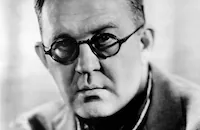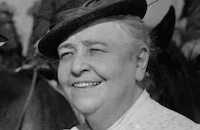3 Godfathers

Brief Synopsis
Cast & Crew
John Ford
John Wayne
Pedro Armendariz
Harry Carey Jr.
Ward Bond
Mae Marsh
Film Details
Technical Specs

Synopsis
Texas outlaws Robert Marmaduke Sangster Hightower, Pedro Roca Fuerte and William Kearny, "The Abiline Kid," arrive in the small town of Welcome, Arizona, to rob a bank. After first meeting Sheriff Buck Perley Sweet and his wife, the three bandits encounter Mrs. Sweet's niece, Ruby Latham, the wife of the town's bank president. The outlaws then proceed to shoot their way into Latham's bank, just as Buck discovers that they are wanted men. The Abiline Kid is wounded in the ensuing shootout with the sheriff and his posse, but he manages to escape into the desert with Pedro and Robert. Back in town, Buck deputizes members of his posse and organizes a manhunt to capture the three desperados who are on horseback. The deputies are sent by train to the Mojave water tank, the nearest source of desert water, where Buck hopes the three outlaws will go. As Pedro, Robert and The Kid approach the water tank, they discover Buck's trap and plan an alternate course. Suspecting that Buck also has men waiting for them at Apache Wells, the next water source, Robert instead plans to head north to Terrapin Tanks and cross the Mexican border at a more remote location. The three bandits soon find themselves in a sandstorm, and later are forced to continue on foot after their horses escape. Meanwhile, Buck and his posse arrive at Apache Wells, and wait for the robbers. When the robbers fail to show up, Buck realizes that they must have doubled back, and goes in search of them. Robert and his men arrive at Terrapin Tanks only to discover that the tanks have been dynamited and contain no water. However, near the water tanks, the three bandits find a pregnant woman alone in a covered wagon. Unknown to the bandits, the woman is Buck's daughter. The bandits take pity on her and help her deliver her child, after which the mother makes the baby's godparents promise to keep her baby from harm. The mother dies a short time later, and the three desperadoes find themselves responsible for the care of the infant. Realizing that by continuing their journey to the Mexican border they will be endangering the infant's life, the bandits decide instead to risk arrest and return to Welcome. While making the dangerous desert crossing, The Kid collapses and dies of thirst. Pedro later breaks his leg in a fall, and shoots himself to relieve Robert of the burden of having to care for him. Braving the punishing desert heat with the infant in his arms, Robert presses onward, stumbling over rocks and finding inspiration in the Bible he carries with him. Soon after arriving in Welcome, Robert enters a saloon and collapses at the feet of Buck and his deputies. Robert and the infant quickly recover from the arduous journey and are taken in by Buck and his wife. A jury finds Robert guilty of robbery, but he receives a light sentence in light of his heroic deed.

Director

John Ford
Cast

John Wayne

Pedro Armendariz

Harry Carey Jr.

Ward Bond

Mae Marsh

Mildred Natwick

Jane Darwell

Guy Kibbee
Dorothy Ford

Ben Johnson

Charles Halton
Hank Worden
Jack Pennick
Fred Libby
Michael Dugan
Don Summers
Francis Ford
Jack Curtis
Crew
James Basevi
Charles Boyle
Jack Caffee
Lucien Cailliet
Don Cash
Merian C. Cooper
Lowell Farrell
Edward Fitzgerald
John Ford
Jack Golconda
Jack Golconda
Harvey Gould
Thomas Griffin
Franz Gruber
Richard Hageman
D. R. O. Hatswell
Winton Hoch
Alex Kahle
Natalie Kalmus
Joseph I. Kane
Patrick Kelley
Joe Kish
Robert Lowry
Anna Malin
Michael Meyers
George A. Minor
Frank Moran
Jack Murray
Frank S. Nugent
Edward O'fearna
Morgan Padelford
Ann Peck
Knowles Shaw
Wingate Smith
Laurence Stallings
Meta Sterne

Photo Collections
Videos
Movie Clip




Trailer
Hosted Intro
Film Details
Technical Specs

Articles
Three Godfathers (1948) - Three Godfathers
Ford chose John Wayne and Mexican star Pedro Armendariz to co-star with Harry Carey, Jr. in the tale of three bad men who find redemption in a barren land. Ford's treatment of actors on his set was legendary. From John Wayne to supporting players, Ford's behavior was often nothing less than harsh. An unfortunate recipient of this abuse on the set of 3 Godfathers was Pedro Armendariz, who happened to be a big star in Mexico. Armendariz showed up on location in Death Valley dressed in a skin-tight black leather costume with silver studs and a big sombrero, thinking he was to be the star of the picture. Ford took him aside and instructed him to forget about looking like a hero, since Armendariz's character was a bandit, a rogue, and a low-life. Ford refitted him with a pair of pants with conchos on the sides, a gringo shirt with flowers on it, a Mexican vest, and an old beat up sombrero. Armendariz went into a rage, but Ford just ignored him. For a horse, an old swaybacked mare with a Mexican saddle was used. Every time Armendariz would complain about his wardrobe or his horse, Ford would go over to the prop truck and get a coffee pot or a frying pan and hang it on Armendariz's saddle, thus accentuating the unglamorous nature of the character.
However, Ford treated no one worse on the 3 Godfathers set than Harry Carey, Jr. Even though Carey had called Ford "Uncle Jack" all his life, he became too frightened of Ford on the set to refer to him by the intimate title. Initially, Ford made it clear to Carey that he was "going to hate my guts before this picture is over," but he did not say exactly why. Ford didn't waste time making his prediction come true. On some days, Ford would demand that Carey bend over so that he could kick him hard for some infraction or mistake Carey had made during a scene. When Carey once had trouble continuing a scene, Ford picked up a rock and lobbed it straight at Carey's face. The actor ducked, and the rock landed square in Pedro Armendariz's stomach. Most often though, Ford simply taunted Carey with audible pronouncements such as, "We should have gotten Audie Murphy!"
But despite his cruelty, Ford was still capable of sensitivity towards Carey. Once Carey's final scenes were shot, Ford commanded him to go home. Carey refused, thinking Ford was just being mean, but Ford won out in the end. As it turns out, Ford still had to shoot the film's pre-credit title sequence, dedicated to the memory of Carey's father. The title read, "Dedicated to Harry Carey, a bright star in the early western sky." Cliff Lyons doubled Harry Carey as the lone rider on Sonny, Carey's favorite horse. The sequence shows Lyons as Carey riding in silhouette to the top of a hill, pushing his hat back on his head, and looking off. Ford knew that watching the scene shot might be too much for the young Carey, so he shielded Carey from it, as a doting "uncle" would a "nephew."
Director: John Ford
Producer: Merian C. Cooper, John Ford
Screenplay: Laurence Stallings, Frank S. Nugent, Peter B. Kyne (story)
Cinematography: Winton Hoch
Editor: Jack Murray
Art Direction: James Basevi
Music: Richard Hageman
Cast: John Wayne (Robert Marmaduke Sangster Hightower), Pedro Armendariz (Pedro Roca Fuerte), Harry Carey Jr. (William Kearney, The Abilene Kid), Ward Bond (Perley "Buck" Sweet), Mae Marsh (Mrs. Perley Sweet).
C-107m. Closed captioning.
by Scott McGee

Three Godfathers (1948) - Three Godfathers
Quotes
A lot of boys stick up stagecoaches and banks and one thing and another. But a man who would dynamite a water hole in this kind of country is downright criminal.- Posse Member #1
I'll be seeing you boys... prob'ly.- Perley 'Buck' Sweet
Trivia
For the scene where Deputy Curly (Hank Worden) has trouble pulling a mule about a train, director 'Ford, John' rigged the reins to pull backwards whenever Worden pulled forward.
Ford had a greensman water a cactus overnight to allow it to be squeezed for water.
This is a remake of John Ford's silent film "Marked Men" (1919) which starred Ford's long-time friend Harry Carey. When Carey died in 1947, Ford decided to remake the story in Technicolor and dedicate the film to his memory. Carey's son, Harry Carey Jr., plays one of the three, "The Abilene Kid".
Notes
The onscreen credits contain the following written dedication: "To the memory of Harry Carey, bright star of the early western sky." Carey, who died on September 24, 1947, was a longtime friend of both John Wayne and John Ford, and starred in two previous screen versions of the story. Peter B. Kyne's short story "Broncho Billy and the Baby," which appeared in The Saturday Evening Post in 1910, is identified in some sources as the basis for his novel The Three Godfathers. The novel first appeared in the same magazine on November 23, 1912. Pre-production news items in Hollywood Reporter noted that Argosy Pictures negotiated a one-picture releasing contract with M-G-M for this film, and that it marked the first time that M-G-M accepted a distrubution deal without a financial investment or creative input in the production.
According to an April 1948 Hollywood Reporter news item, director John Ford initially planned to film the picture in Mexico. The film was shot on location in Death Valley, CA, with some additional shooting in Lone Pine, CA. Hollywood Reporter also notes that some filming was set to take place at RKO's Culver City studios. As noted above, other screen adaptations of Kyne's story include the 1916 Bluebird film The Three Godfathers, directed by Edward J. Le Saint and starring Harry Carey and Stella Razeto; the 1919 Universal picture Marked Men, directed by John Ford and also starring Carey (see AFI Catalog of Feature Films, 1911-20; F1.4453 and F1.2823); a 1930 Universal picture called Hell's Heroes, directed by William Wyler and starring Charles Bickford (see AFI Catalog of Feature Films, 1921-30; F2.2414); and a 1936 M-G-M film directed by Richard Boleslawski and starring Chester Morris and Lewis Stone (see AFI Catalog of Feature Films 1931-40; F3.4609). A made for television version of the story, entitled The Godchild, appeared on the ABC network in 1974, directed by John Badham and starring Jack Palance.

Miscellaneous Notes
Released in United States Winter January 1949
Released in United States Winter January 1949
















